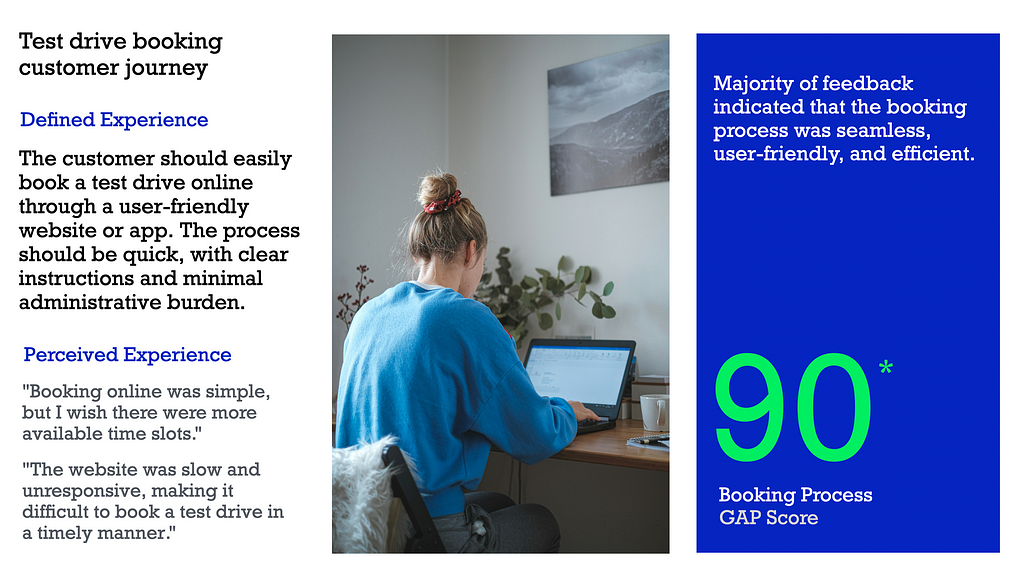Discover how leveraging AI can uncover hidden opportunities and address unknown gaps to elevate customer satisfaction and increase customer loyalty.

According to PwC,
73% of consumers point to customer experience as an important factor in their purchasing decision, and 32% of all customers would stop doing business with a brand they loved after just one bad experience (World Economic Forum).
Also, research done by Baine & Company (founder of NPS) concludes:
80 % of CEOs believe they deliver a superior customer experience, only 8 % of their customers agree.
That’s the “delta/gap” someone has to deal with 🫠.
By definition, a CX gap is the discrepancy between what customers expect and what they experience with a product or service. For instance, if you are offering a complex service but fail to provide adequate onboarding, this could create an experience gap. Essentially, an experience gap occurs when a company falls short of meeting customer expectations. Identifying these gaps is crucial for pinpointing weaknesses and gaining valuable insights, which can improve long-term business performance or the opposite, increase churn.
The problem and approach
A significant challenge organizations still face is how to gather relevant feedback from crucial moments throughout the customer journey and then turn insights into opportunities that ultimately improve CX.
For a team with high empathy, it can be difficult NOT to respond to a frustrated customer, even if the experience was intentional by design. However, focusing solely on negative feedback will not help achieve that CX vision statement on the wall. Instead, it can lead to a directionless path where the reward is merely the number of resolved issues rather than improved business performance. That’s why you need to look for insights, not just random feedback.
Doing what’s right
- Start by defining each key experience where customers interact with your brand. Without definitions, customer feedback is close to meaningless.
- Ensure feedback is captured for each key experience. Creating a before, during, and after framework to ideate cx measurement and questions to ask, will be a good start for creating a strong listening path.
- Visualize and compare intended CX with current experience. Conduct an Experience Gap Analysis to establish a foundation for what to prioritize and why. Make sure suggested opportunities improve both CX and business performance.

Step-by-step guide
It is essential to prepare and plan accordingly to identify future opportunities that reveal where the organization is lagging and the underlying reasons for these shortcomings.
- ⭐ CX Definition — Core steps of the customer journey with defined aspects
- 👱🏽 Capture feedback — Plan where and how to gather feedback and CX measurements
- 📥 Feedback categorization — Categorise data based on defined experience aspects
- 🧪 Gap analysis — Conduct sentiment analysis and calculate Gap Score
Say hello to EV Everyday 👋
To illustrate how to set this up efficiently, let’s set up a fictional company called EV Everyday (EVE). EVE offers tested, new, and pre-owned electric vehicles, along with market-leading insurance, all at an affordable monthly subscription cost. The journey that we will be focusing on is the Test Drive Experience. Let’s follow a methodical process through EV Everyday.
1. Customer Experience Definition
Customers don’t just compare prices anymore; they compare pretty much everything, including brand experiences. That’s why CX Definitions are crucial for ensuring clarity and consistency across all customer interactions. It should align the organization with a common goal, set benchmarks for satisfaction rates, and identify areas for improvement. It also guides resource allocation for maximum impact on business performance.
Test Drive Experience
EVE enables test drives of their fleet of EV cars. A nice way to not only introduce the brand but also let customers experience the unique aspects of EVs. Below is a simplified CX definition of the EVE TD customer experience journey.
The CX definition includes key stages, with connected aspects and descriptions. Remember, mapping is not enough, make sure it’s actionable.

2. Capture customer feedback
Now that the CX definition is set, it makes sense to plan what to measure throughout the TD Experience. At a high level, we aim to understand each stage of the journey, while also delving into various aspects by incorporating operational questions. See the example below on what to measure and when.
Choose the method of feedback collection based on customer preferences. Ensure to combine data from various sources to capture the full experience. These sources might include online reviews, customer care inquiries, surveys -, and social media data. This comprehensive approach will provide a holistic view of the TD experience.

3. Feedback categorization
Performing automatic feedback categorization typically requires knowledge of Natural Language Processing (NLP) and statistical programming. Feedback management software companies have successfully integrated these capabilities. However, even though they promise ML models tailored to your industry, feedback needs to be analyzed based on your intended experience, not your competitors. Here, OpenAI can provide a qualified alternative to expensive tools and hours of coding.
How it can be done:
- First, we will generate some test data for training purposes using OpenAI and ChatGPT
- Next, we will save the dataset in Excel format for future backup
- Then upload earlier documented Experience Definition in Excel format
- Finally, we will match the gathered customer feedback with the defined aspects.
I recommend using OpenAI APIs instead of ChatGPT. Also, If you’re concerned about data security and compliance make sure to run the analysis in a safe environment like Microsoft Azure OpenAI Service. At least always filter sensitive customer data before using services like ChatGPT.
GPT Prompt 1:
Create a dataset for an EV car company that includes customer feedback
about their test drive experiences. The dataset should contain 10 rows
spanning a 6-month period and include the following attributes: country,
location, EV car model, customer satisfaction score, and written customer
feedback of varying lengths.
Insructions:
- Ensure that each feedback entry is unique and not duplicated.
- Do not provide Python code examples.
- When you’re done, please ask if I would like to generate 10 additional
rows until you reached 100 rows.
GPT Prompt 2:
Once all data is created, save the dataset as Excel and provide a
download link, name the file "EV_Everyday_Customer_Feedback.xlsx".
Next, we match the received feedback with defined aspects. Start by uploading your TD Experience Definitions containing stage, aspects, and, details, then prompt the instruction for the matching process.
Then provide GPT with instructions on how to match our Experience Definition with the received customer feedback before calculating the Gap Score.
GPT Prompt 3:
Input Data:
- Experience Definitions containing details of aspects
- Experience Feedback containing customer feedback
Task Instructions:
- Match all Aspects based on the description in the Details column with the Customer Feedback using natural language processing
- Enhance the matching accuracy by considering synonyms and related phrases
Generate a new table containing:
- Aspect
- Expected Experience
- Feedback Summary (provide a cohesive, objective summary for each
aspect, avoiding first-person narratives and ensuring comprehensive
coverage of key points).
Ensure to iterate the prompt-text if you are not satisfied with the result. Consider extending the summary, listing both negative and positive experience drivers and more. This is a skill set that will grow with experience. The result below shows a glimpse of what feedback that could be tied to the intended experience.

4. Experience Gap Analysis
This will be our last step which will include calculating the Gap Score. Let’s proceed with our fourth instruction.
GPT Prompt 4:
Conduct a Gap Analysis and compare defined experience with feedback.
- Identify areas where expectations are met and not, and explain why.
- Quantify how well aspects are met on a scale of 0-100%.
- Keep Aspects, Expected Experience, Gap Analysis and score,
remove Feedback Summary
First, relevant feedback is matched with the defined aspects using AI to identify similar words and synonyms. Then the sentiment of each matched sentence is assessed, with scores ranging from -1 (very negative) to +1 (very positive), and neutral feedback falling between -0.5 to 0.5. The total number of positive sentences is divided by the number of negative feedback comments, then multiplied by 100 to obtain a percentage score between 0%-100%.


By following these four steps, we gained valuable insights into what’s working and what is falling short of expectations. We also identified areas that need to be addressed, including ideas for resolving experience gaps and ultimately achieving our North Star CX vision.
Another invaluable resource for gaining a comprehensive view of the customer experience is incorporating customer inquiries into Customer Service. While customer feedback provides direct responses to your questions, the questions customers ask can highlight deficiencies in your experience.
Fredrik Sterner Cederlöf
Principal Analyst. Insight Works AB
Customer experience gap analysis: detecting opportunities with ChatGPT was originally published in UX Collective on Medium, where people are continuing the conversation by highlighting and responding to this story.


Leave a Reply